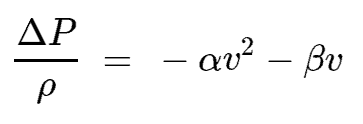Welcome to the first Volupe blog post of this year, this week we will look deeper into porous baffles. A porous baffle is a lumped model used to model and simulate flow through a thin porous geometry, for example a perforated plate, porous membrane or a wire screen. A porous baffle is two dimensional (no thickness) which means that neither the geometry nor the flow inside the thin porous geometry is resolved. By setting appropriate porous baffle properties, like porosity and resistance parameters, you can capture essential flow characteristics like pressure drop and flow direction without meshing and solving for this thin porous region.
Definitions of the baffle properties
When you have defined your interface as a porous baffle you will see the interface tree structure looking as in the picture below.

The three physical parameters for a porous baffle are:
- Porosity – A value between 0 and 1, where the coefficient is corresponding to how open the flow path through the baffle is. Meaning that 1 is a fully open channel (for a fully open channel there is no wall shear stress applied).
- Porous inertial resistance – The coefficient describing inertia when fluid is trying to be accelerated or deaccelerated.
- Porous viscous resistance – The coefficient describing viscous effects on a fluid particle, either due to friction from another fluid particle or a wall.
Note regarding porosity: When running steady state simulations, the porosity does not affect the pressure drop over the baffle, but in transient simulations porosity does affect the pressure drop. In the Siemens article about how porosity affects the pressure drop over a porous baffle, this is described more in detail. In porous regions the porosity is mainly used for calculating the superficial velocity, so for porous baffles it is used for calculating the heat and mass transfer.
How to calculate resistance parameters
The equation relating the resistances to pressure drop for a porous baffle is

which looks similar to the equation for porous regions

The coefficients alpha and beta, in the porous baffle equation, are representing the porous inertial resistance and porous viscous resistance respectively. Attached to the Siemens article about how to calculate porous coefficients, there is an Excel sheet where you can calculate the coefficients so they match your experimental data. The first tab of the sheet is for calculating coefficients when using porous regions, and the second tab is for porous baffles.
Note regarding porous baffle properties: When assigning values to the porous baffle properties, it should be noted that all coefficients, porosity and resistance parameters, should not be zero. If all values are zero, the solver can become less stable.
Shear stress or resistance based baffles
There are two different types of porous baffles, shear stress and resistance based. The default treatment is shear stress based, which should be used if the velocities on the two sides of the baffle are different. This type of baffle is often used when the flow upstream of the baffle is mostly tangential to the baffle surface. For this type of baffle the flow downstream will become perpendicular to the baffle. For turbulent flows, this option is appropriate if the turbulence has a scale that reduces significantly at the baffle.
The picture below shows a simulation of flow going from left to right, with periodic boundaries on the floor and roof of the channel. In this simulation a shear stress based porous baffle is located in the middle which directs the flow in normal direction downstream.

If the baffle is supposed to only create a pressure drop, while preserving the flow direction the resistance based porous baffle treatment can be used. With this treatment there will be tangential resistances possible to specify, like in the picture below.

Setting the tangential resistances to zero will preserve the energy in the tangential direction and allow the flow to have a direction which is not aligned with the normal of the baffle. See picture below for results of the simulation from previous example but with resistance based treatment with zero tangential resistance.

The resistance based baffle is often used when modelling open baffles where the upstream flow is mainly normal to the baffle. For turbulent flows, this option is appropriate if the holes in the baffle are such that their characteristic length is similar to the length scale of the turbulence.
We at Volupe hope that you have got a great start of the new year, and that you enjoyed this blog post. If you have any questions about porous baffles or other types of simulation, please reach out to us at support@volupe.com.
Author
Christoffer Johansson, M.Sc.
support@volupe.com
+46764479945
